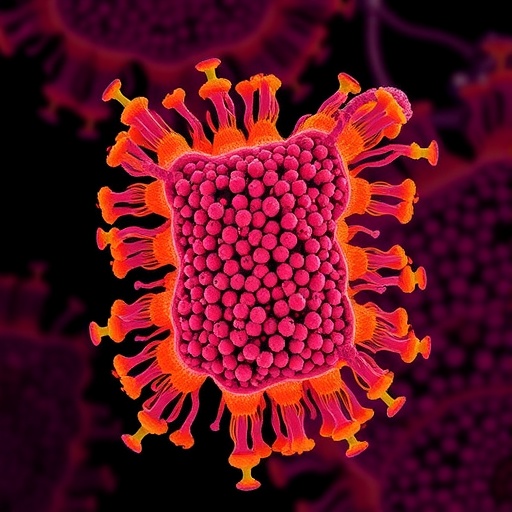
In an era where the pursuit of predictive medicine is gaining momentum, researchers are actively seeking biomarkers that can provide early indicators of complex conditions such as diabetic peripheral neuropathy (DPN). The phenomenon of DPN stands as one of the most common complications associated with diabetes, impacting millions worldwide and often leading to significant morbidity if and when it develops. In a groundbreaking study, Zhuang, Hu, and Cai delve into the potential of blood viscoelasticity testing parameters as promising candidates for predicting the onset of DPN. Their findings mark a pivotal step in understanding the nuanced interplay between blood properties and diabetic complications.
At the heart of the research is the concept of blood viscoelasticity—essentially the measurement of blood’s ability to deform and flow under stress. This property is crucial not only in determining how effectively blood circulates throughout the body but also in assessing the microcirculation, particularly in the distal ends where conditions like DPN can manifest. By examining various parameters of blood viscoelasticity, the researchers aim to establish a correlation between these parameters and the early indicators of DPN, ultimately paving the way for better predictive strategies.
The methodology employed by Zhuang et al. involved a comprehensive study involving diabetic patients at different stages of the condition. Through a series of rigorous tests, they examined the viscoelastic properties of blood samples, using state-of-the-art equipment that ensures accuracy and reliability of results. These tests assess various aspects of blood flow, including shear stress and strain, which are critical in understanding how blood behaves in the circulatory system. Such thorough testing is invaluable, as it lays a solid foundation upon which further analysis can be conducted.
One notable aspect of the study is the comparison of viscoelastic parameters among patients with and without DPN. By contrasting these groups, the researchers were able to distill significant differences that could aid in identifying those at risk of developing the condition. This comparative approach highlights the potential of these biomarkers to serve not only as indicators of current health status but also as tools for preemptive intervention in high-risk populations.
In conjunction with the analysis of viscoelastic parameters, the study incorporates various clinical evaluations that enrich the understanding of DPN’s multifaceted nature. For instance, patient histories and physical examinations were crucial elements in interpreting the data collected. This holistic approach ensures that the findings are grounded in real-world clinical contexts, increasing their validity and potential application in everyday healthcare scenarios.
The results of the analysis are not only promising but also complex. Zhuang et al. reveal that certain viscoelastic parameters exhibit a strong correlation with the presence of DPN, suggesting that these measurements could be integrated into routine clinical assessments. The prospect of having a blood test that can indicate vulnerability to this debilitating condition is revolutionary. It spurs discussions about a paradigm shift towards more preventive healthcare approaches rather than solely reactive treatments once symptoms become apparent.
Moreover, the implications of this research extend beyond just blood viscoelasticity. It opens up avenues for further exploration into other potential biomarkers that might be utilized in conjunction with viscoelastic measurements. The interplay between metabolic factors, blood properties, and neural health creates a complex web that warrants deeper investigation. Such a multidisciplinary approach could yield a treasure trove of insights that span genetics, biochemistry, and neurology.
As the researchers continuing to analyze the data, they are also keenly aware of the limitations and challenges that lie ahead. While the initial results are compelling, it is imperative to replicate the findings across larger and more diverse populations to ensure the applicability of the results. Future studies should seek to refine the parameters further, potentially harnessing advanced computational models to predict individual risks with even greater precision.
The potential for integrating blood viscoelasticity testing into routine screenings for diabetic patients could transform the landscape of diabetes management. The current model, which often reacts to complications rather than prevents them, may evolve into a proactive strategy that emphasizes monitoring and early intervention. For patients, this could mean a significant reduction in the incidence and severity of DPN, leading to improved quality of life and lower healthcare costs associated with managing complications.
The study by Zhuang, Hu, and Cai thus stands at the intersection of innovation and necessity. The alarming rise in diabetes prevalence worldwide calls for urgent responses from the medical community. By harnessing the insights gained from their research, healthcare professionals may soon have the tools necessary to shift from a reactive to a proactive care model, emphasizing prevention and patient education as cornerstones of diabetes management.
In summary, the research elucidates an innovative pathway toward understanding and mitigating the risks associated with diabetic peripheral neuropathy through blood viscoelasticity. The findings reinforce the notion that subtle changes in blood properties can yield significant insights into conditions that affect millions. The continued exploration of this relationship holds the potential not only to enhance predictive capabilities but also to foster a deeper understanding of the physiological changes associated with diabetes as a comprehensive syndrome.
As we anticipate further developments from this research, it is clear that the implications extend well beyond the laboratory. The conversation about diabetes management is evolving, and studies like this will undoubtedly play a pivotal role in shaping future research agendas, clinical practices, and ultimately improving health outcomes for diabetic patients everywhere.
In conclusion, the contributions made by Zhuang, Hu, and Cai cannot be underestimated. Their work shines a light on an innovative approach to one of the most pressing health issues of our time. As research progresses, the hope is to see these promising biomarkers transition from theoretical concepts to practical applications, heralding a new era in diabetes care that prioritizes prevention and proactive health management.
Subject of Research: Blood viscoelasticity as biomarkers for diabetic peripheral neuropathy.
Article Title: Parameters of blood viscoelasticity testing as promising biomarkers for the prediction of the occurrence of diabetic peripheral neuropathy.
Article References:
Zhuang, Y., Hu, X., Cai, Q. et al. Parameters of blood viscoelasticity testing as promising biomarkers for the prediction of the occurrence of diabetic peripheral neuropathy.
BMC Endocr Disord 25, 167 (2025). https://doi.org/10.1186/s12902-025-01993-2
Image Credits: AI Generated
DOI:
Keywords: Blood viscoelasticity, diabetic peripheral neuropathy, biomarkers, predictive medicine, diabetes management.
Tags: biomarkers for diabetic complicationsblood properties and healthblood viscosity testing for diabetescomplications of diabetes mellitusdiabetic neuropathy predictionearly indicators of diabetic neuropathymicrocirculation and diabetespredictive medicine in diabetesprevention strategies for diabetic complicationsresearch on diabetic peripheral neuropathysignificance of blood flow in diabetesviscoelasticity in blood flow




